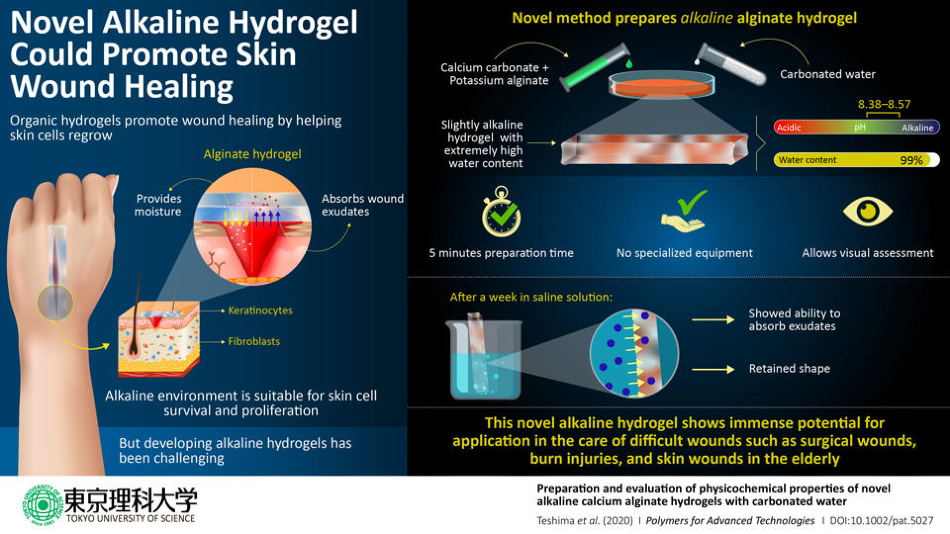Aug 27 2020
For wound care to be effective, it is essential to maintain conditions that are ideal for the regeneration of skin and tissue. Although hydrogels offer most of these conditions, they cannot maintain an alkaline environment.

Image Credit: Tokyo University of Science.
Taking a huge step forward, researchers from the Tokyo University of Science, Japan, have now devised a new technique that can be used to produce an alkaline hydrogel in just five minutes. The new technique also avoids the need for specialized equipment and can be carried out at room temperature, enabling its easy implementation in any medical practice for best-in-class wound healing.
Wound healing has turned out to be a crucial area of focus in medicine due to an increase in the aging and elderly population, as well as the number of invasive surgeries. The complex bodily processes that form part of wound healing render it not only challenging but also rewarding to find novel materials and techniques for effective wound healing.
As part of a new study, reported recently in Polymers for Advanced Technologies and headed by undergraduate student Ryota Teshima, scientists from Tokyo University of Science have created a revolutionary, innovative material with potential applications in wound healing. But why is this new material so fascinating?
Making an ideal physiological environment around a wound is very essential to promote the growth of new cells. Recent studies have shown that a kind of material known as “hydrogel” is extremely useful in realizing such conditions, thanks to its unique molecular structure. Hydrogels are three-dimensionally cross-linked networks of polymers with the potential to absorb over 95% of their volume in water.
Hydrogels made of natural polymers exhibit higher compatibility with the biological conditions of human skin and tissues (also called “biocompatibility”). Moreover, they can absorb fluids from the wound and continuously offer moisture to the wound, creating a highly desirable environment for wound healing.
Alginate, a carbohydrate extracted from seaweed, is one such natural polymer used in hydrogels for wound dressing. It is abundantly available. Although alginate gels are very simple to produce, gelation tends to occur very fast, which makes it hard to control the gelation time.
Several techniques to realize this control have been reported earlier, but maintaining a short gelation time while retaining transparency leads to hydrogels with a slightly acidic (4–6) or neutral pH.
Although researchers had until recently believed that slightly acidic conditions are beneficial for the wound to heal, new studies have discovered that a slightly alkaline pH (8–8.5) is suitable for nurturing the growth of “skin healing” cells like keratinocytes and fibroblasts.
This is the concept underlying the properties of the next level alginate hydrogel synthesis technique developed by Mr Teshima and his team.
We have succeeded in preparing a novel alkaline alginate hydrogel (pH 8.38–8.57) suitable for wound healing via a method that requires no special equipment and can be carried out at room temperature. This, in addition to the fact that the hydrogel forms in 5 minutes, makes it ideal for potential use in any medical practice anywhere for superior wound healing.
Ryota Teshima, Undergraduate Student, Tokyo University of Science
In the new technique, potassium alginate and calcium carbonate are combined, and carbonated water is then added to this mixture for the “gelation” (gel formation) process to occur. Here, the pH of the gel turns alkaline as the carbon dioxide tends to volatilize following gelation.
This also ensures transparency of the gel, which in turn enables the visual evaluation of wounds and assists in easily verifying the progress of healing. Moreover, irrespective of the amounts of ingredients used, the resultant hydrogels tend to exhibit very high water content of up to 99%.
Upon placing the hydrogel in a physiological saline solution, it passed the test for another crucial requirement for a wound dressing, which is the ability to absorb exudates from the wound. Even when the hydrogel turned structurally weak and could not be removed with tweezers after a week of immersion, it had retained its shape.
I have been experimenting with alginate gels ever since junior high school. There was also increasing interest in regenerative medicine when I was growing up, which compelled me to focus on the creation of useful biocompatible materials that can be used in medical therapy.
Ryota Teshima, Undergraduate Student, Tokyo University of Science
Mr Teshima, therefore, described the inspiration behind this fascinating study.
No one can deny the huge potential exhibited by the innovative hydrogel created by Mr Teshima’s team for near-future application to wound healing in medicine.
With the hopes of much more prospective applications of their technique in medicine beyond wound healing, Mr Teshima added, “In the future, if it is possible to control the sustained release of an effective drug held inside it, this novel hydrogel can be used as a drug carrier as well.”
As for now, the subsequent step would be to evaluate its effectiveness and viability in living cells and animal models. Once this is achieved, Mr Teshima’s Japan and, eventually, the world can turn into a better place.
Journal Reference:
Teshima, R., et al. (2020) Preparation and evaluation of physicochemical properties of novel alkaline calcium alginate hydrogels with carbonated water. Polymers for Advanced Technologies. doi.org/10.1002/pat.5027.